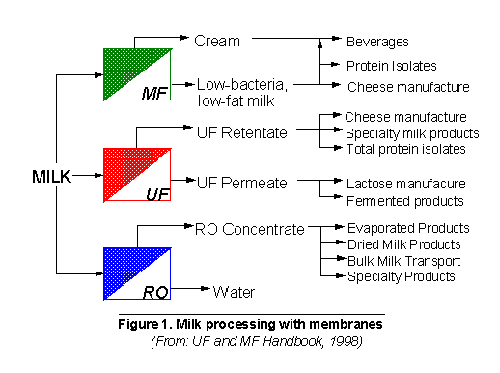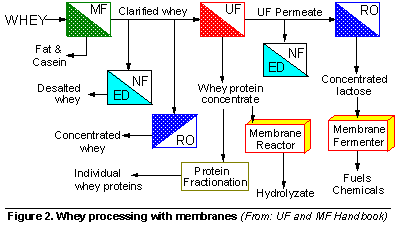|
The University of Illinois at Urbana-Champaign has a history of research and development in dairy technology stretching back to the early 1900s. Research on the application of immobilized enzymes and membrane technology in milk and whey processing began in 1975. The potential application of membranes in the dairy industry is vast, as shown in Figure 1 for milk and in Figure 2 for cheese whey. Current estimates are that over 300,000 square meters of membrane area are installed in the dairy industry worldwide. Present usage is weighted towards reverse osmosis (RO) and ultrafiltration (UF), although there are expectations of significant growth in microfiltration (MF) and nanofiltration (NF) in the next decade.
A good example of the successful application of membrane technology, and ultrafiltration in particular, is the processing of cheese whey. Whey is a by-product of the cheese industry. It is the liquid fraction that is drained from the curd during the manufacture of cheese. Typically every 100 kg of milk will give about 10-20 kg of cheese depending on the variety, and about 80-90 kg of liquid whey. Its disposal is a major problem for the dairy industry, partly due to its composition. It has a low solids content and a very unfavorable lactose:protein ratio which makes it difficult to utilize as-is. The biological oxygen demand (BOD) is 32,000 to 60,000 ppm, which creates a very severe disposal problem. Despite continuing efforts to find uses for the whey, either as-is or in dry form, or its major components (high quality protein and lactose), it is estimated that as much as 40-50% of the whey produced is disposed off as sewage, with the rest being used primarily for animal feed or human food. World production is estimated at 80 to 130 million tons per year with USA producing about 30 million tons per year. Since cheese consumption is increasing around the world, we can assume that the whey disposal problem is getting worse. This explains why membrane technology has attracted the attention of cheese and whey producers: the appropriate membrane can simultaneously fractionate, purify and concentrate whey components, thus enhancing their utilization and reducing the pollution problem. Figure 2 shows a general schematic of possible applications of membranes in whey treatment.
Some of the applications of membranes in cheese whey processing include:
The production of blends of dairy and vegetable proteins has also been examined using co-extraction and co-ultrafiltration. This process was developed specifically to meet the demand for functional food ingredients that combine the versatility and functionality of dairy proteins with the economy of vegetable proteins. The major advantages are:
Some portions of this page are excerpted from Ultrafiltration and Microfiltration Handbook by Munir Cheryan, Ph.D., published by CRC Press, Boca Raton, FL (1998). More details and references available in this book.
 Publications on this topic Publications on this topic Research -- Other topics Research -- Other topics Updated April 2005 by mcheryan@uiuc.edu |

